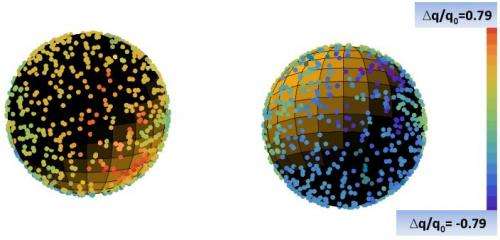September 7, 2011 weblog
New evidence for a preferred direction in spacetime challenges the cosmological principle

(PhysOrg.com) -- According to the cosmological principle, there is no special place or direction in the universe when viewed on the cosmic scale. The assumption enabled Copernicus to propose that Earth was not the center of the universe and modern scientists to assume that the laws of physics are the same everywhere. Due to the cosmological principle, scientists also assume that the universe is “homogeneous” - having a uniform structure throughout - and “isotropic” - having uniform properties throughout.
But a few recent studies have found the possible existence of cosmological anisotropy: specifically, that the universe’s expansion is accelerating at a faster rate in one direction than another. In the most recent study, scientists have analyzed data from 557 Type 1a supernovae and found, in agreement with some previous studies, that the universe’s expansion seems to be accelerating faster in the direction of a small part of the northern galactic hemisphere.
The researchers, Rong-Gen Cai and Zhong-Liang Tuo from the Chinese Academy of Sciences in Beijing, have posted their study at arXiv.org.
A valuable tool for cosmologists, Type 1a supernovae serve as “standard candles” due to their consistent peak luminosity, allowing researchers to measure their distance with high accuracy. Observations of these supernovae famously revealed in 1998 that the universe is not only expanding, but is doing so at an accelerating rate. And now, some observations of Type 1a supernovae at different locations in the sky hint that the acceleration is not uniform in all directions.
In their analysis, Cai and Tuo looked at the deceleration parameter, q0, to quantify the anisotropy level of the northern galactic and southern galactic hemispheres. As the scientists explain in their study, the direction with the smaller value of q0 is expanding faster than the direction with the larger value. The researchers analyzed the data using both a dynamical dark energy model and a standard model without dark energy, and found that both models revealed similar results: an anisotropy deviation of 0.76 and 0.79, respectively, and a preferred direction of (309°, 21°) and (314°, 28°), respectively. As noted by the Physics arXiv Blog, this direction of greatest acceleration is in the faint constellation of Vulpecula in the northern hemisphere.
But as Cai and Tuo note in their study, the case is far from closed. In contrast with the current results, some previous analyses of Type 1a supernovae data have not found any statistically significant evidence for anisotropies. And many other data - such as that for the cosmic microwave background radiation, galaxy statistics, and dark matter haloes - strongly support the assumption of homogeneity and isotropy on the cosmic scale.
Yet considering that the cosmological principle is one of the pillars of modern cosmology whose fundamental importance is difficult to exaggerate, threats to its credibility won’t be taken lightly. If the cosmological principle turns out to be wrong, it would dramatically change the way we look at the world.
More information:
Rong-Gen Cai, et al. "Direction dependence of the acceleration in type Ia supernovae." arXiv:1109.0941v2 [astro-ph.CO]
via: Physics arXiv Blog
© 2011 PhysOrg.com

















